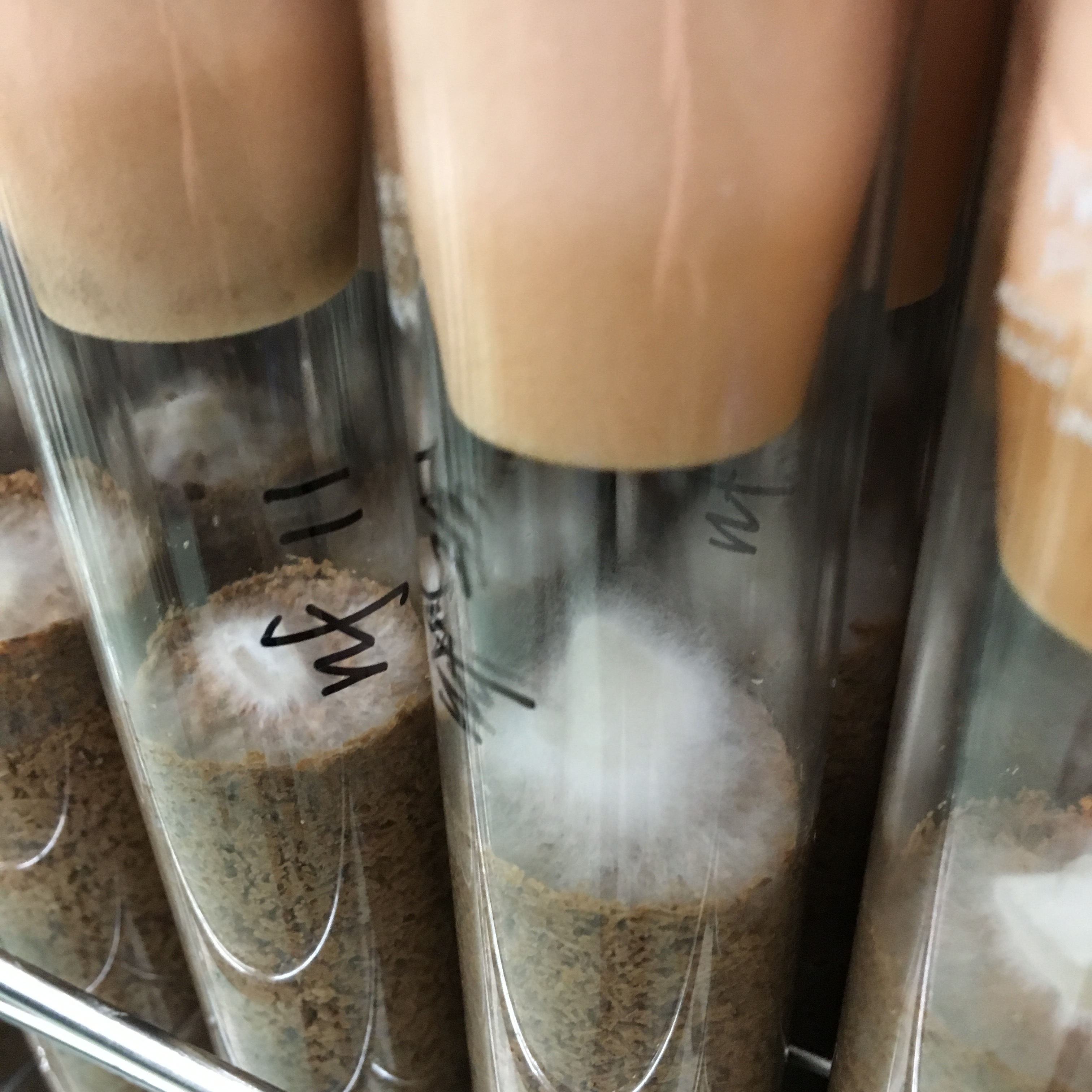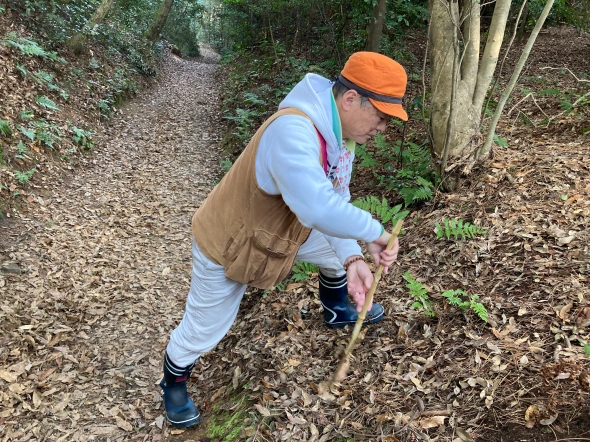Shiitake vs Streptococcus pyogenes

Japanese follows below. 日本語は英文下に。
The highly contagious bacteria that cause the infection can, in some cases, cause serious illnesses, health complications and death, particularly in adults over 30. About 30% of STSS cases are fatal
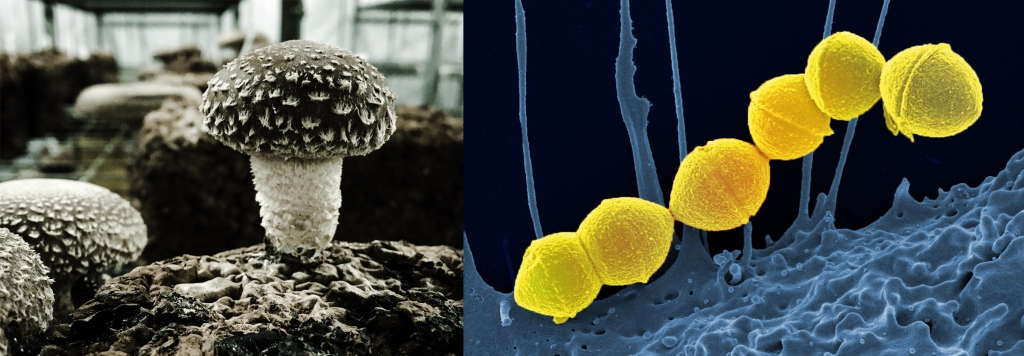
“Experts warn that a rare but dangerous bacterial infection is spreading at a record rate in Japan, with officials struggling to identify the cause.
The number of cases in 2024 is expected to exceed last year’s record numbers, while concern is growing that the harshest and potentially deadly form of group A streptococcal disease – streptococcal toxic shock syndrome (STSS) – will continue to spread, after the presence of highly virulent and infectious strains were confirmed in Japan” – J. McCurry, Mystery in Japan as dangerous streptococcal infections soar to record levels, The Guardian (2024). https://www.theguardian.com/world/2024/mar/15/japan-streptococcal-infections-rise-details.
This form of Strep A is a nasty one. In his Guardian article (June 15th, 2024) Justin writes:
“Most cases of STSS are caused by a bacterium called streptococcus pyogenes. More commonly known as strep A – it can cause sore throats, mainly in children, and lots of people have it without knowing it and do not become ill. But the highly contagious bacteria that cause the infection can, in some cases, cause serious illnesses, health complications and death, particularly in adults over 30. About 30% of STSS cases are fatal”.
Across the globe, as drug-resistant pathogenic microorganisms proliferate, medicinal mushrooms (MMs) are being researched as never before as weapons in the fight against disease. In in vitro testing, a component derived from the edible shiitake mushroom has shown antimicrobial effectiveness against Streptococcus pyogenes to a degree that matches antimicrobial drugs.
A 2001 paper from Hungary suggests the effetive substance is likely lenthionine. “The mycelium-free culture fluid [derived from Lentinus edodes, Shiitake] was bacteriostatic against Streptococcus pyogenes, Staphylococcus aureus and Bacillus megaterium. The substance responsible for the activity was heat-stable, could be extracted with chloroform and had a molecular weight under 10000. These characteristics suggested that the component might be lenthionine, an antibacterial and anti-fungal sulphur-containing compound”.
@medicinalmushroom, @fungi, @Japan, antibiotic-resistance, Health, medicinal mushrooms, Mushroom, mushroomsThe paper then reassuringly adds “The culture fluid was less toxic to human tissue culture cells than to microbes.”
The following, from research conducted in Ireland in 2009, indicates the humble shiitake’s usefulness in a number of antimicrobial applications: “Several batches of Shiitake and oyster mushrooms were purchased fresh from a local supermarket and underwent aqueous extraction of potential antimicrobial components. After reconstitution, aqueous extracts were tested qualitatively against a panel of 29 bacterial and 10 fungal pathogens, for the demonstration of microbial inhibition. Results: Our data quantitatively showed that Shiitake mushroom extract had extensive antimicrobial activity against 85% of the organisms it was tested on, including 50% of the yeast and mould species in the trial. This compared favourably with the results from both the Positive control (Ciprofloxacin).”
J. R. Rao, B. C. Millar, J. E. Moore, Antimicrobial properties of shiitake mushrooms (Lentinula edodes). International Journal of Antimicrobial Agents 33, 591–592 (2009).
Shiitake offer other health benefits too. Lentinan is a polysaccharide extracted from Shiitake. β-Glucan is its major bioactive component, and has proven immunostimulatory effect. Its antitumor properties were recorded in the 1960s and it has been approved as an adjuvant therapeutic drug in China and Japan for treating cancers since 1980s. However, globally more often than not products derived from MMs – shiitake included – are marketed as ‘dietary supplements’.

Read more about its likely anti-tumor, cholesterol-lowering, immunostimulant, antiviral and antibacterial properties at the excellent, ever erring-on-the-side-of-caution, Memorial Sloan Kettering Cancer Center’s About Herbs site.
I’m lucky enough to live in Japan where there is a cheap and plentiful supply of Shiitake. I will make a decoction – aka, aqueous extract/fabulous dashi – and a tincture soon, and post more info here in case you’d like to try it yourself.
シイタケ対化膿レンサ球菌
希少だが危険な細菌感染症が日本で記録的な勢いで蔓延していると専門家が警告しています。 A群溶血性レンサ球菌感染症の中でも最も過酷で死に至る可能性のある「溶連菌中毒性ショック症候群(STSS)」が日本で確認されたことで、2024年の患者数は昨年の記録数を上回ると予想されています。
このA型溶連菌は厄介なものです。ジャスティンはガーディアンの記事(2024年6月15日)でこう書いています:
「STSSのほとんどは、化膿レンサ球菌と呼ばれる細菌によって引き起こされます。一般的には溶連菌Aとして知られているこの細菌は、主に子供たちの咽頭炎を引き起こします。しかし、この感染症の原因となる感染力の強い細菌は、特に30歳以上の成人では、場合によっては重篤な病気や健康合併症、死亡を引き起こすことがあります。STSSの約30%は死に至ります」。J. McCurry, Mystery in Japan as dangerous streptococcal infections soar to record levels, The Guardian (2024). https://www.theguardian.com/world/2024/mar/15/japan-streptococcal-infections-rise-details.
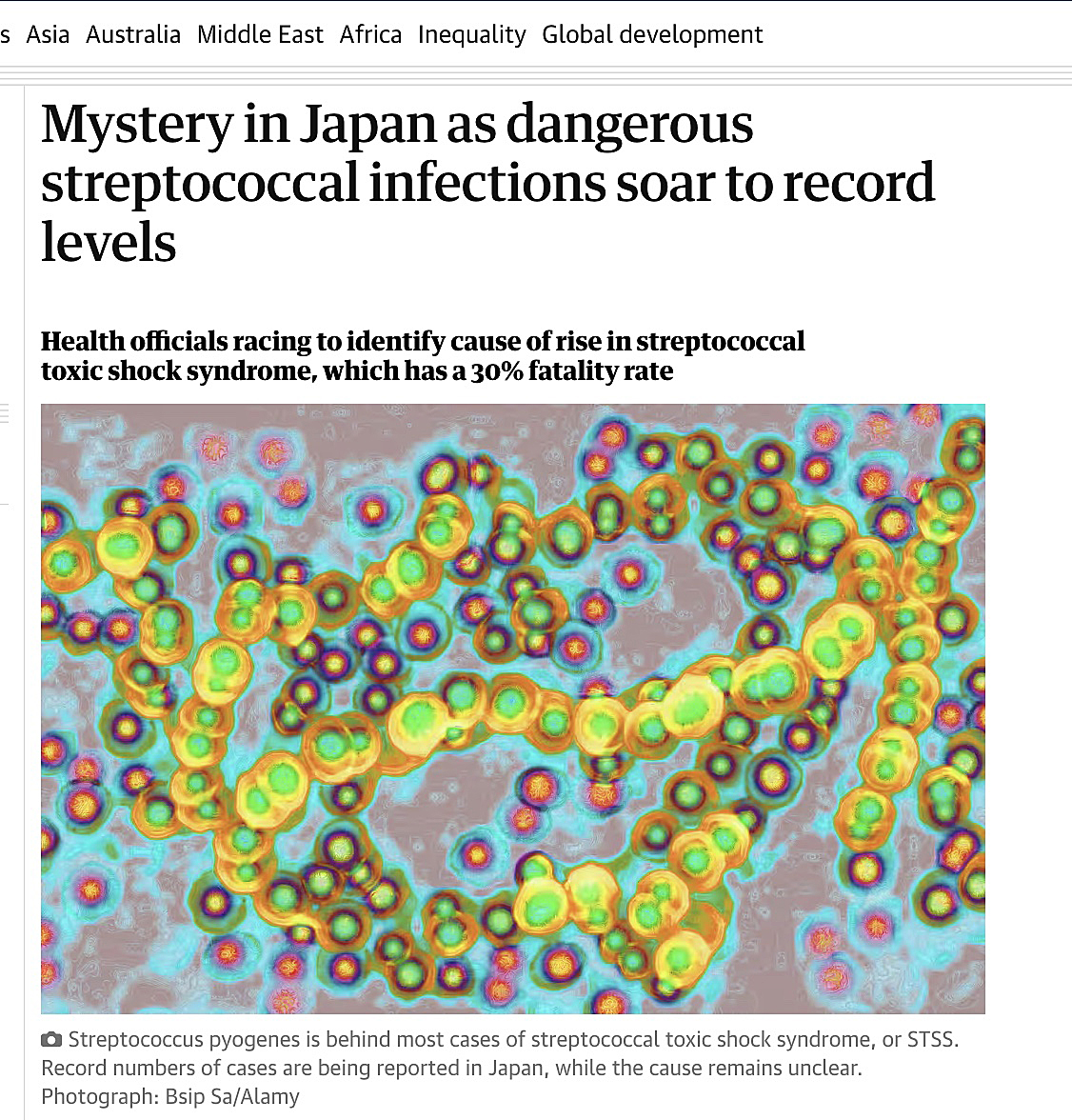
世界中で薬剤耐性の病原性微生物が増殖する中、薬用キノコ(MM)は病気と闘うための武器として、かつてないほど研究が進められています。化膿連鎖球菌の場合、実験室でのテストでは、地味なシイタケ由来の成分が抗菌効果を示しました。
以下は、2009年にアイルランドで行われた研究によるもので、地味なシイタケが多くの抗菌用途に有用であることを示しています:
2001年にハンガリーで発表された論文によると、これはレンチオニンかもしれません。「菌糸体を含まない培養液(Lentinus edodes, Shiitake由来)」は、Streptococcus pyogenes、Staphylococcus aureus、Bacillus megateriumに対して静菌性を示しました。活性の原因物質は熱に強く、クロロホルムで抽出でき、分子量は10000以下でした。これらの特徴から、この成分は抗菌・抗真菌性の含硫化合物であるレンチオニンである可能性が示唆されました」。
そして、この論文は、”培養液は、微生物よりもヒト組織培養細胞に対する毒性が低かった “と付け加えています。
地元のスーパーマーケットから新鮮なシイタケとヒラタケを数バッチ購入し、内在する抗菌成分を水抽出しました。再構成後、水性抽出物を29種類の細菌および10種類の真菌病原体パネルに対して定性試験を行い、微生物阻害を実証しました。その結果、シイタケ抽出物は、試験対象となった酵母およびカビ種の50%を含む85%の生物に対して、広範な抗菌活性を有することが定量的に示されました。これは、陽性対照(シプロフロキサシン)の結果と比較すると、良好な結果でした。J. R. Rao, B. C. Millar, J. E. Moore, Antimicrobial properties of shiitake mushrooms (Lentinula edodes). International Journal of Antimicrobial Agents 33, 591–592 (2009).
シイタケには他にも健康効果があります。レンチナンはシイタケから抽出される多糖類です。β-グルカンはその主要な生理活性成分で、免疫賦活作用が証明されています。その抗腫瘍作用は1960年代に記録され、1980年代以降、中国や日本ではがんの補助治療薬として承認されています。しかし、世界的には、シイタケを含むMM由来の製品は、「栄養補助食品」として販売されることが多くなっています。 抗腫瘍作用、コレステロール低下作用、免疫賦活作用、抗ウイルス作用、抗菌作用については、メモリアル・スローン・ケタリングがんセンターの「ハーブについて」のサイトをご覧ください。
私は幸運にも日本に住んでいて、安くて豊富なシイタケが手に入ります。近々、煎じ薬とチンキを作る予定です。@medicinalmushrooms @fungi @Japan @fungiJapan
How to Make Simple Medicinal Mushroom Extracts (part two – the water decoction)

On Your Mark, Get Set, Boil and Simmer
This is second part of the method described in an earlier post, what is known as a double or dual extraction.
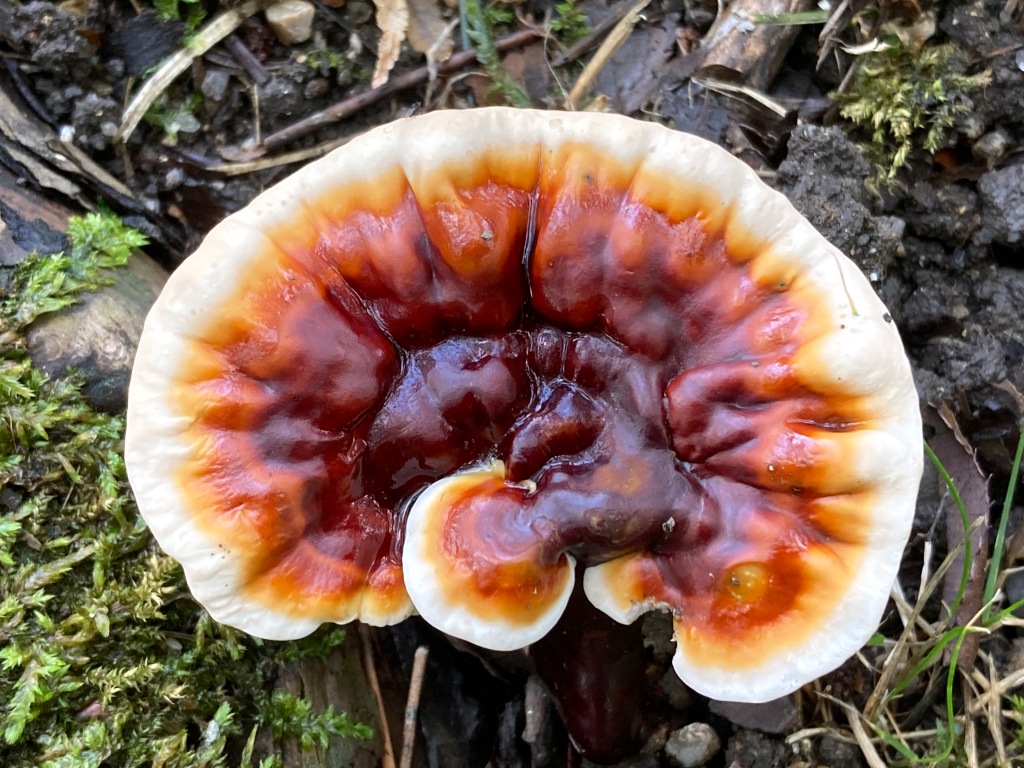
To recap, we are looking at a duel extraction process here, with two steps, using alcohol and water. That is to say, steeping the mushrooms in alcohol (making a tincture) and boiling the mushrooms in water (making a decoction). You can do this with the same batch of mushrooms. Indeed, this is the least wasteful approach, and the most cost effective. You get more out of your mushrooms this way.
However, if you decide to make a tincture with one batch of mushrooms, and a decoction with another set of mushrooms – the other half of your harvest, perhaps – and keep them separate, that’s fine too.
Making the decoction
To begin your ‘marc’, the mushrooms left over from the alcohol soak, or fresh mushrooms, and soak them in water in a large pot. If you are using fresh mushrooms, make sure to scrub off as much dirt – and bugs – as possible. I generally rinse fresh mushrooms, soak them in water for a while, then dry them overnight in my drier. This stops any moud creeping in. The green meanies seem to go for reishi as soon as you bring them out of the forest. Here’s what my drying process looks like:
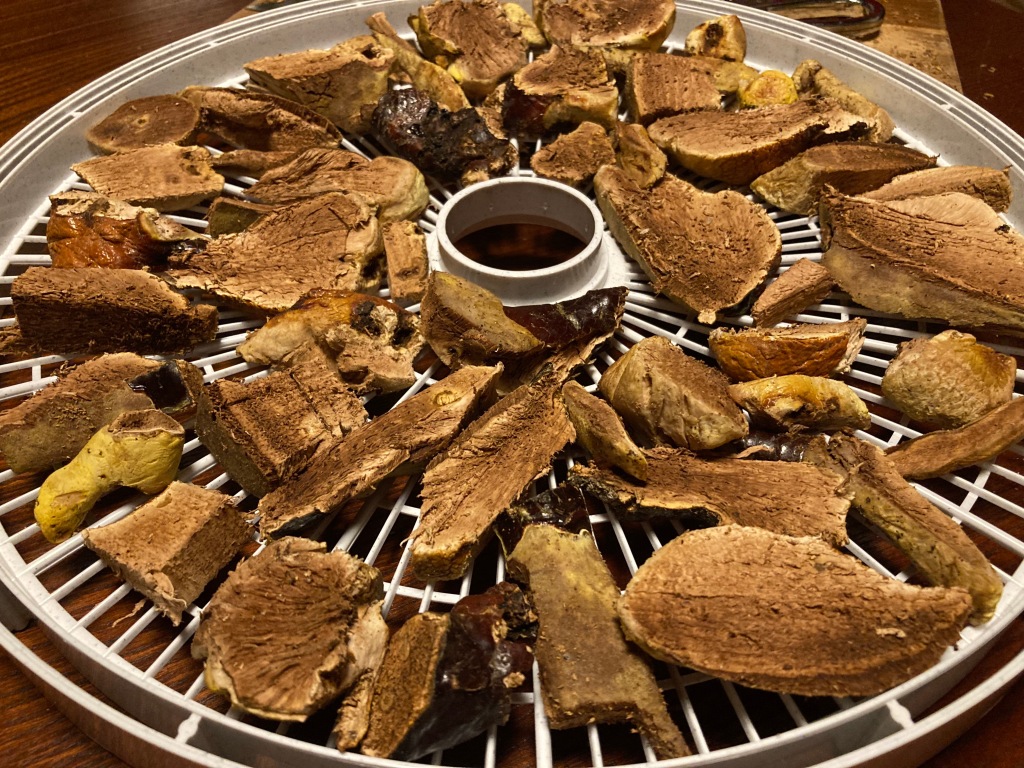
As you’ll not, I sliced these reishi up to dry. They were pretty tough, so it took some effort. I used a saw, a chisel and finally scissors to get them down to size. Younger specimens are easier to slice.

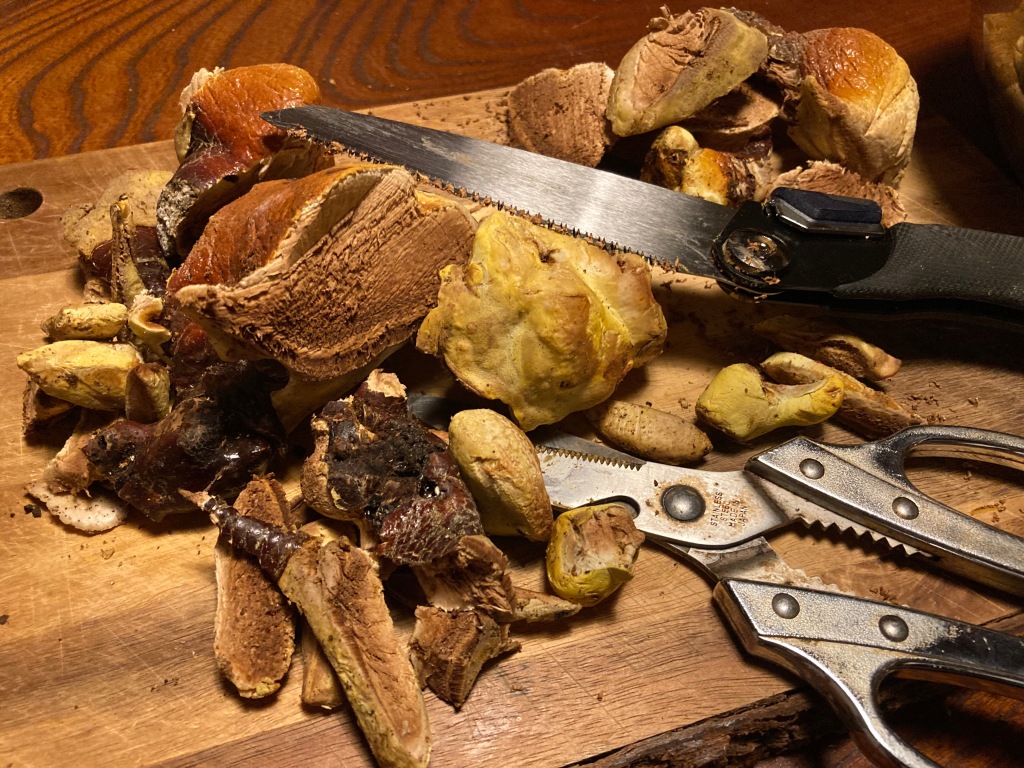
Boiling/Simmering and a Recipe
A quick net search will show you that there are many different recommendations for how long to heat the mixture. I follow my Japanese ‘Mushroom master’ Shuji Sano’s advice.
- Take 50 grammes of Medicinal mushrooms
- Add them 2 litres of water in a large saucepan
- Bring to a boil, then reduce to a simmer
- Let the mixture simmer for an hour, or until the liquid has reduced by half
- Filter off the liquid (I use a kitchen drain net)
- Et voila, you have a litre of Medicinal mushroom decoction.
Sano-san combines 40 grammes of Reishi (Ganoderma lucidum) with 10 grammes of Artist’s Conk (Ganoderma applanatum). How you take it is up to you. Mrs A and I add 25 ml to our morning smoothies, along with several drops of the Medicinal mushroom tincture mentioned previously.
How to Make Simple Medicinal Mushroom Extracts (part one – the alcohol tincture)

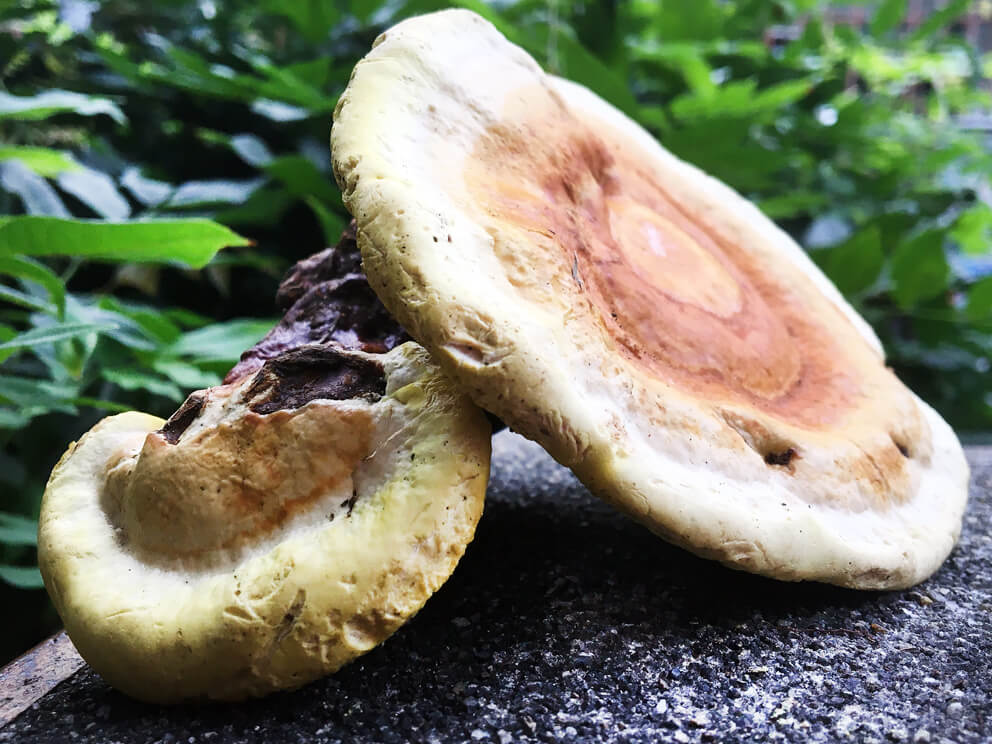
Reishi, aka Ganoderma lucidum, undisputed heavyweight champion of medicinal mushrooms. I harvested these for my extracts last July from the grounds of a forest temple here in Kyoto.
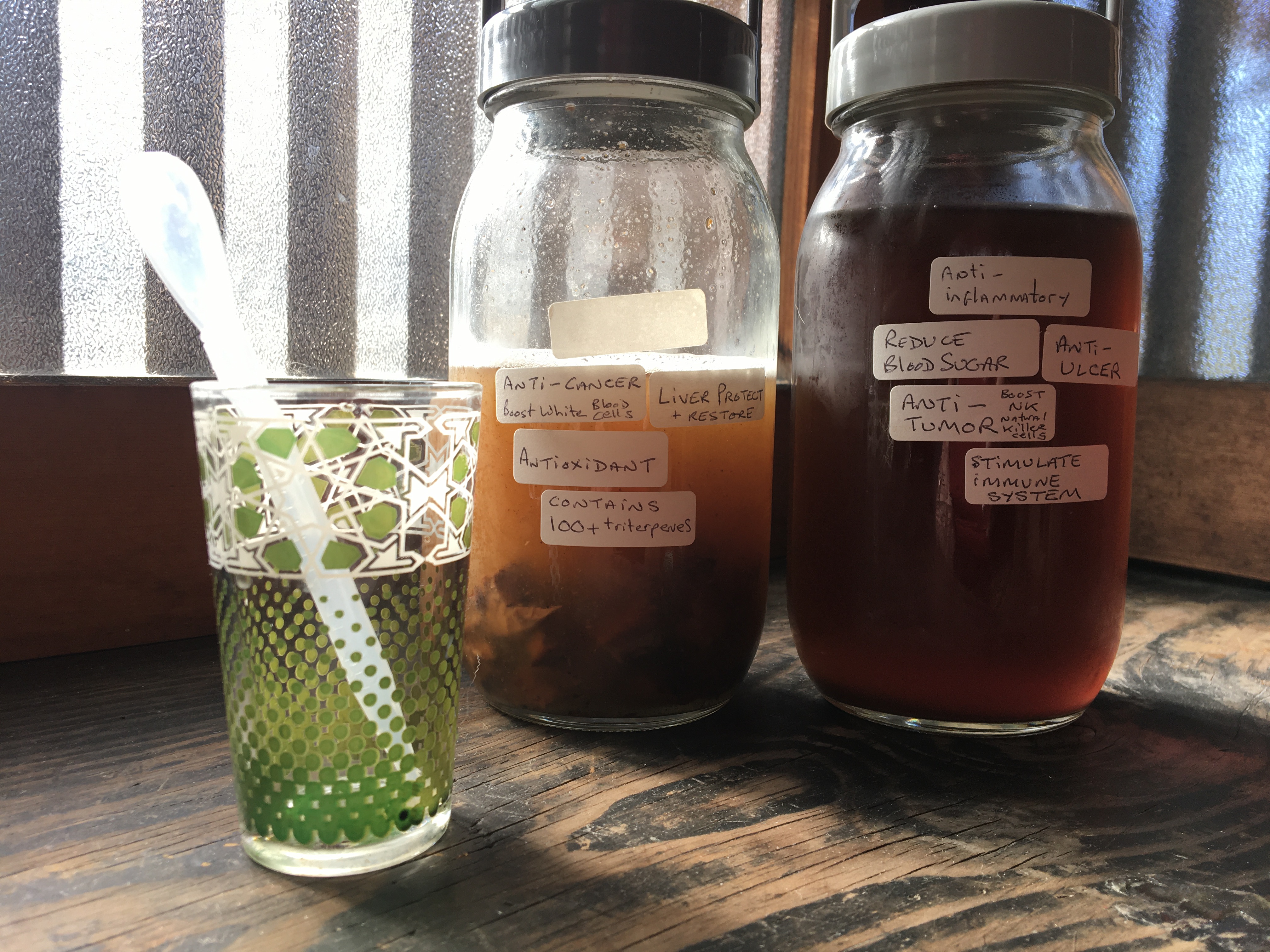
To the left, a tincture (alcohol extraction) to the right a decoction (water extraction). To get the most out of your medicinal mushrooms, combine the two in a single concoction (blend).
Greetings! If you are reading this, I take it you are interested in making some medicinal mushrooms, so here we go, I’ll outline the basics. Before we start, I should point out that I won’t be delving into complex techniques or terminology such as extraction ratios, (if you want to know about those, and bags of good info, check here), or carefully measuring out each milligramme and milliliter of ingredients. Nor am I talking industrial scale production. I’ll just show how I make medicinal mushroom extracts, for me and my significant other, here in our small wood and paper house in Kyoto, Japan. I’ll keep it simple.
By the way, it’s a long post. You might like to pull up a chair.
From start to finish the process takes about 4 weeks, less if you are in a hurry. The most complex equipment you’ll need is a big pan, or pressure cooker, and some glass jars.
Double, Double, Boil & Bubble
The method I’ll describe is what is known as a double or dual extraction. Simply put, mushrooms contain health-giving components that need to be eked out using one of two methods: boiling in water, or steeping in alcohol. If you only do one part of the two-step process, fine, but you’ll miss out on half the good stuff. More on the good stuff later.
If you are going to use mushrooms you found in the forest, don’t forget the mushroom gatherer’s timeless advice: “All wild mushrooms are edible. Once”.
Firstly, you’ll need some mushrooms. I am fortunate, living in Japan, in that I can source fresh medicinal mushrooms – maitake, shiitake, enokidake, shimeji, etc – inexpensively at farmer’s markets and organic stores and supermarkets pretty much year-round. My Kyoto house is not far from the hills, so foraging is not difficult either. I’ll write more about that another time, but if you are going to use mushrooms you found in the forest, don’t forget the mushroom gatherer’s timeless advice: All wild mushrooms are edible. Once.
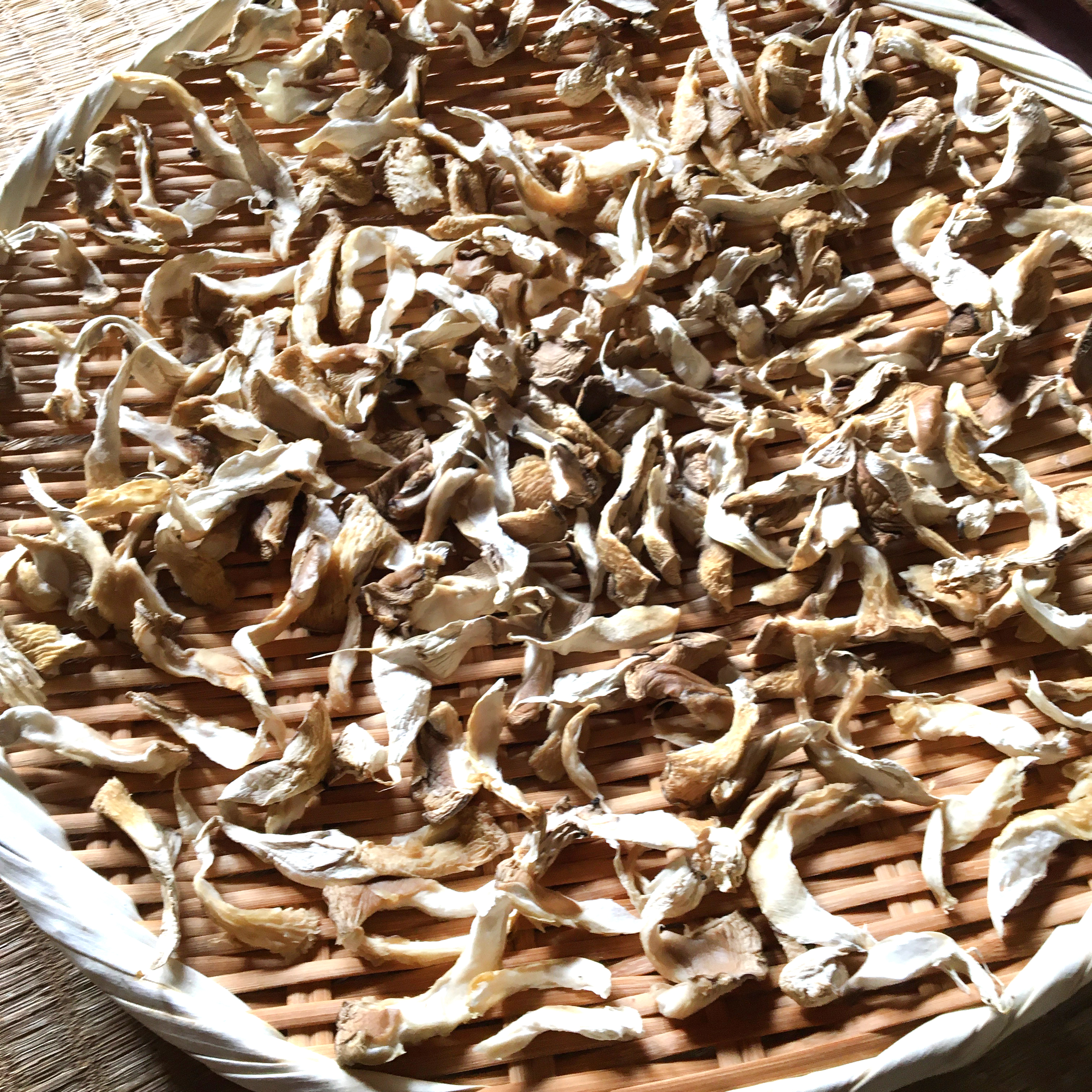
Sun drying Yanagimatsutake. Get double quantity and make a risotto with the other half. Awesome!
I almost always use dried mushrooms when making my concoctions (that’s not a rude word in these circles, by the way). Using fresh mushrooms is fine, but sun drying ups the Vitamin D content exponentially (good for vegans and vegetarians), and of course it makes storing and handling that much easier.
While we are here, drying some species of mushroom – porcini, yanagimatsutake, cèpes, boletes – then reconstituting them by adding water, makes them even tastier than when fresh. There’s a chemical explanation for this, I’m sure. I just don’t know what it is. Flavonoids? This man likely knows the answer.
First, take some Mushrooms
So, here we go. First, take your mushrooms, make sure they are clean, chop them into small pieces, dry them, and you are ready to go. Sounds easy, right? Well, it is, unless of course one of the mushrooms you have chosen happens to be or good friend, the incomparable, Ganoderma lucidum or reishi. These are seriously tough mushrooms. Literally tough. Not so long ago my mushroom comrade in arms Irish Tom and I managed to splinter an electric saw blade trying to slice up a particularly feisty example.
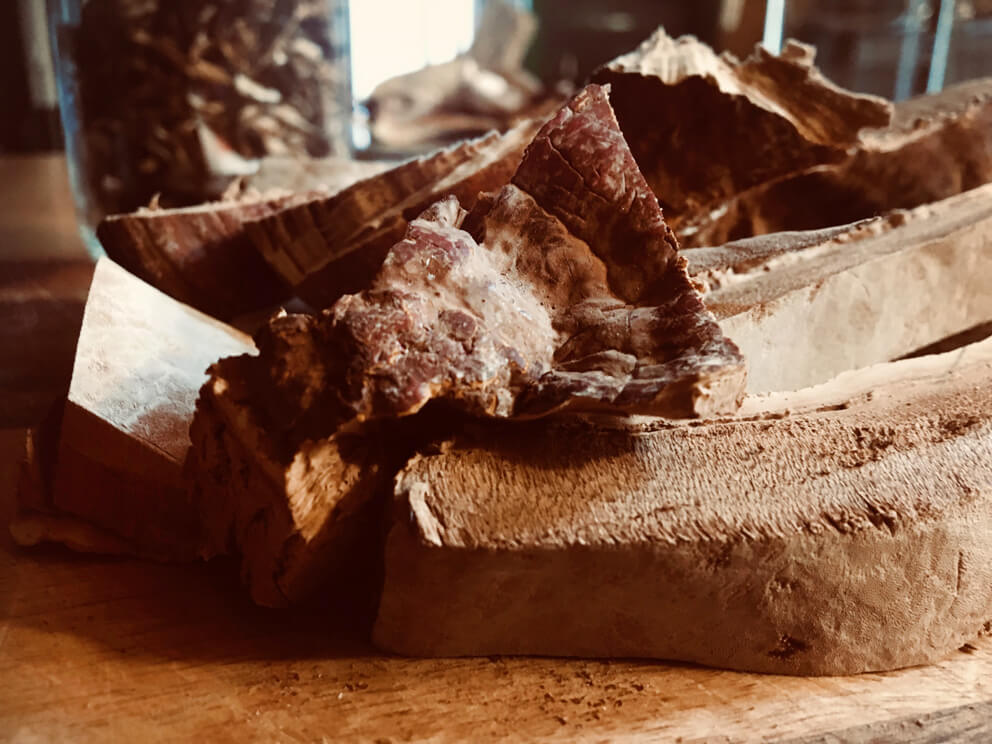
Look for grain to cut across when slicing reishi. The first cuts across the cap are the toughest. Across the slice is easier.
A simple way to get around the problem is to buy ready-cut reishi chips, or commercially-produced dried mushrooms which are generally easy (easier, more accurately) to slice. For the latter a good heavy-handled knife is handy, as is a hefty chopping board on a stable surface. Experiment slicing across the cap until you find a ‘grain’ that is easier to follow. Even with store-bought reishi, expect to work up a sweat. You might like to play some relaxing music. Or thrash metal. For a super hard shroom from the forest you’ll need a saw.
Fortunately, many dried mushrooms are easy to make smaller, and often you can pull them apart by hand – a very satisfying feeling (or is that just me?) – or cut them with kitchen scissors. Some crumble to the touch.
The choice of mushrooms is pretty much up to you, and of course you can include different mushroom species in one concoction. If you are creating a medicinal mushroom extract to suit a particular health condition, or to protect in advance against a certain ailment, then you can tailor your mycological ‘mix and match’ to suit. I’ll write on which mushrooms are most suitable for which conditions here at a later date.
Steep, then Boil (or, if you fancy it, boil, then steep)
To recap, we are looking at a duel extraction process here, with two steps, using alcohol and water. That is to say, steeping the mushrooms in alcohol (making a tincture) and boiling the mushrooms in water (making a decoction). You can do this with the same batch of mushrooms. Indeed, this is the least wasteful approach, and the most cost effective. You get more out of your mushrooms this way.
However, if you decide to make a tincture with one batch of mushrooms, and a decoction with another set of mushrooms – the other half of your harvest, perhaps – and keep them separate, that’s fine too.
 There is some debate in which order you should do the dual extraction. I’m a steep first, boil later guy. Some dudes go for the boil, then steep. Huh? It’s a bit like Jonathan Swift’s debate over which end you should eat your boiled egg from. I guess I’m a Big Endian, Steep Firster. There is evidence that both processes, whichever you choose, may slightly reduce the effectiveness of the second step, but for our purposes, the difference is negligible. My reason for steeping in alcohol first is that it is easy, and I’m putting off the (only slightly) less easy bit till later.
There is some debate in which order you should do the dual extraction. I’m a steep first, boil later guy. Some dudes go for the boil, then steep. Huh? It’s a bit like Jonathan Swift’s debate over which end you should eat your boiled egg from. I guess I’m a Big Endian, Steep Firster. There is evidence that both processes, whichever you choose, may slightly reduce the effectiveness of the second step, but for our purposes, the difference is negligible. My reason for steeping in alcohol first is that it is easy, and I’m putting off the (only slightly) less easy bit till later.
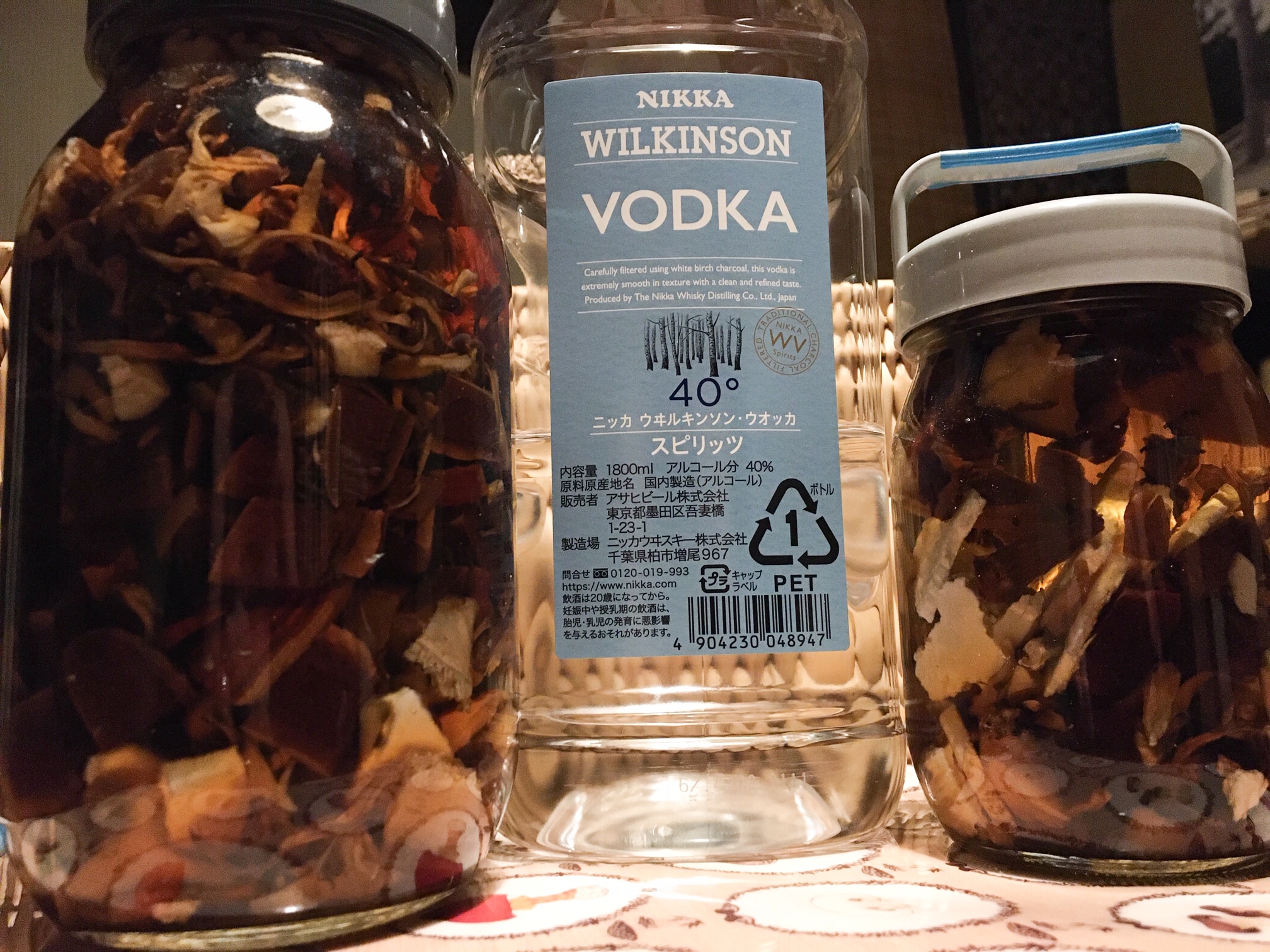
First step: steep your mushrooms in alcohol. 40% – 50% proof vodka is just the job.
Making the tincture (at last, I hear you say)
Clean a large glass jar, and fill to the half way point with your mushrooms. Then fill to the brim with 40~50% proof vodka. Try to not let any air remain. As you’ll see from the above, there’s no point in splashing cash with fine quality alcohol, as your final concoction will taste of, well, mushrooms. With reishi in there, bitter mushrooms.
A jar with a handle on top is, well, handy, as you can easily agitate it, that is to say, shake it up and down like someone possessed. To get the most from your mushrooms it is recommended you do this daily, but it’s not a catastrophe if you forget. Whilst agitating I suggest you put on a Pointer Sisters record and pretend to yourself you are doing a 1980s aerobics workout. Just don’t let anyone see you do this. If you are reading this in Japan, Seria has perfect jars at ¥100 a pop.
Leave your medicinal mushrooms in a cool, dark place for 4 weeks, agitating daily. That can include making ‘F#c% Trump!’ placards and encouraging youth to vote. Over time the mixture may cloud, but worry not, that’s normal. A water extraction clouds even more so.
I recommend you label your jars with the date laid down, the type of mushrooms within, and whether the contents are a tincture (alcohol) or an extraction (water). It’s easy to forget, if you don’t. You can scrawl on them with a marker pen, or print dainty labels. I like to label mine in, er, Latin. Yes, I know the ‘Pretentious, moi?’-ometer just broke off the top of the scale, but I like it. There’s also another reason for using scientific names, which I’ll get to in another post sometime. Et voilà, your tincture.
Come back here in four weeks for the next exciting installment, aka, How to Make Simple Medicinal Mushroom Extracts (part two – the water decoction).
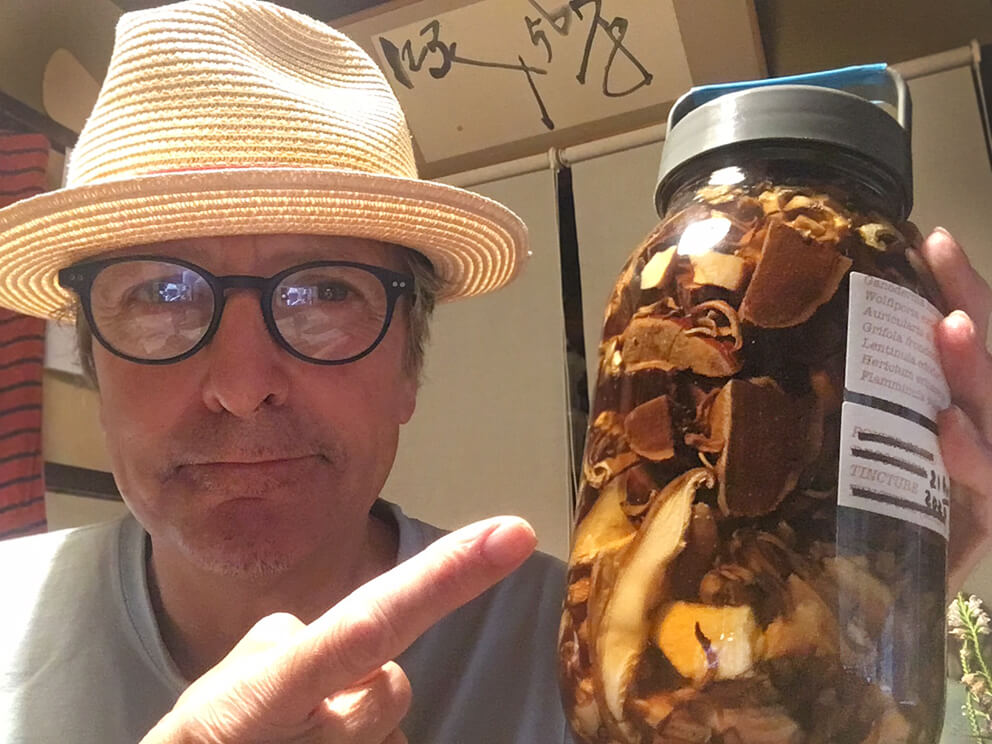
Store your tincture in a cool, dark place for about four weeks, agitating daily. Yeah!

